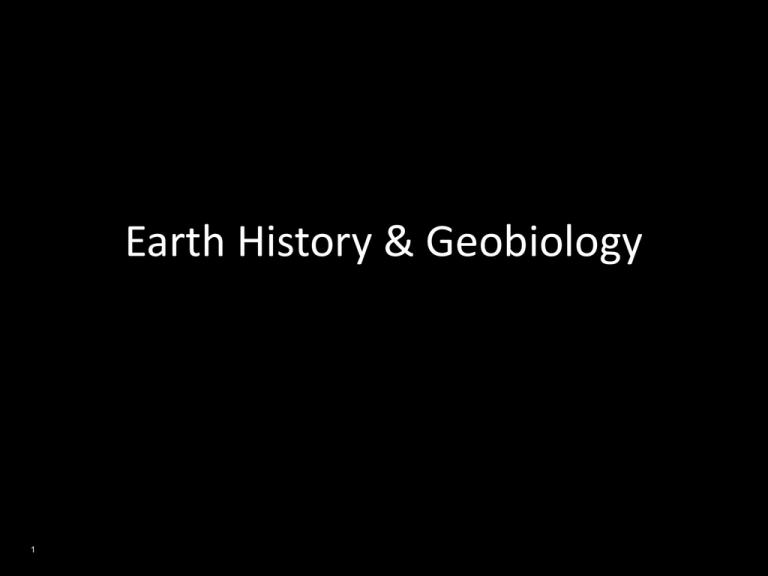
Earth History & Geobiology
1
Chronology of the early Earth
2
4567 Ma: Formation of Solar system (Pb-Pb)
0
4530±10: Core segregation (Hf-W-U-Pb)
30-50
4480±20: Moon forming event (Rb-Sr)
70-110
4450±50: Accretion of Earth nearly complete
<4450±50: formation of the Atmosphere (I-Xe)
120±50
>120±50
4420±80: Formation of the oldest Crust (Sm-Nd)
140±80
4417 Ma: oldest minerals on Moon (Zircon)
150
4404 Ma: oldest minerals on Earth (Zircons from Aus)
163
4000 Ma: oldest preserved continental crust
570
Photograph courtesy of NASA. Image in the public domain.
Why does the Earth have so much water ?
Photograph courtesy of NASA. Image in the public domain.
3
Hydrogen loss
Image by Boris Starosta © John Wiley & Sons. All
rights reserved. This content is excluded from our
Creative Commons license. For more information,
see http://ocw.mit.edu/help/faq-fair-use/.
•
•
•
•
•
•
•
•
4
accretion of the early earth due to impact of numerous planetesimals
Thereby native iron was added to the >1000 oC hot surface.
gas
On the surface iron reacts with H2O: Fe0 + H2O = FeO + H2
Even today on Earth (final size) H and He can escape,
Only the two lightest elements can reach the escape velocity
of ~ 40,300 km/h (11 km/s)
The early earth had no magnetic field so solar wind reached
earth surface enhancing the loss of the atmosphere
mass
H2
2
He
4
CH4
16
CO2
44
N2
28
O2
32
Ar
40
5
© W. H. Freeman and Company. All rights reserved. This content is excluded from our Creative
Commons license. For more information, see http://ocw.mit.edu/help/faq-fair-use/.
Why does the Earth have so much water ?
Evidence for surface water
© source unknown. All rights reserved. This content is excluded
from our Creative Commons license. For more information, see
http://ocw.mit.edu/help/faq-fair-use /.
Photograph courtesy of NASA. Image in the public domain.
6
Likely added by a later event…
Hydrogen 1H
Likely most of the volatiles
elements originate from meteorites
Deuterium 2H
The D/H of comets
is distinctive different
from Earth
7
© source unknown. All rights reserved. This content is excluded from our Creative
Commons license. For more information, see http://ocw.mit.edu/help/faq-fair-use/.
Comets are “dirty snowballs”, composed of dust and ice
Photograph courtesy of NASA. Image in the public domain.
8
Halley’s Comet
Artist's recreation of late heavy bombardment event removed due to copyright restrictions.
We think the water was added by the late heavy
bombardment event.
9
Impact rate on the Earth
Earth is to small during the main accretion event to retain hydrogen
H2O react with Fe to FeO and H2
→ depletion of H, noble gases etc.
Giant impact add additionally energy –
Volatile elements get “lost in space”
Evidenz für Ozeane
Later addition of volatiles by a “late heavy bombardment”
Evidence for it are observed on the moon
(ages spectra of impact melts), indirect evidences on Earth.
“late heavy bombardment” might not happen
in all planetary systems
10
© source unknown. All rights reserved. This content is excluded
From our Creative Commons license. For more information, see
http://ocw.mit.edu/help/faq-fair-use/.
Analyses of oxygen isotopes in Zircons
possible indicate presence of water at > 4 Ga
U-Pb + Trace elements
oxygen
U-Pb
© source unknown. All rights reserved. This content is excluded
from our Creative Commons license. For more information, see
http://ocw.mit.edu/help/faq-fair-use/.
11
We formed a early earth but what were the condition on It?
Courtesy of Brian Smallwood. Used with permission.
12
13
© sources unknown. All rights reserved. This content is excluded from our Creative
Commons license. For more information, see http://ocw.mit.edu/help/faq-fair-use/.
14
© sources unknown. All rights reserved. This content is excluded from our Creative
Commons license. For more information, see http://ocw.mit.edu/help/faq-fair-use/.
BIF:
Banded Iron
Formations
Chert (=SiO2) coated with Fe-Oxide
Magnetite-layers(FeIIFeIII2O4)
15
© sources unknown. All rights reserved. This content is excluded from our Creative
Commons license. For more information, see http://ocw.mit.edu/help/faq-fair-use/.
Presence of free water is puzzling given the
low luminosity of the young sun.
16
© sources unknown. All rights reserved. This content is excluded from our Creative
Commons license. For more information, see http://ocw.mit.edu/help/faq-fair-use/.
17
© sources unknown. All rights reserved. This content is excluded from our Creative
Commons license. For more information, see http://ocw.mit.edu/help/faq-fair-use/.
Feedback between silicate weathering
and CO2 sequestering.
© sources unknown. All rights reserved. This content is excluded from our Creative
Commons license. For more information, see http://ocw.mit.edu/help/faq-fair-use/.
18
Timeline of earth history removed due to copyright restrictions.
19
Courtesy of NASA. Image in the public domain.
Some people, like Fred Hoyle, proposed that life came
from another planets with the help of meteorites..
20
Stanley Miller and
Harold Urey showed,
that aminoacids can
easily be produced on
earth surface
© sources unknown. All rights reserved. This content is excluded
21 from our Creative Commons license. For more information, see
http://ocw.mit.edu/help/faq-fair-use/.
They simulated lightning in a
oxygen free atmosphere
22
© sources unknown. All rights reserved. This content is excluded from our Creative
Commons license. For more information, see http://ocw.mit.edu/help/faq-fair-use/.
Alternatively life might
have originated at the
bottom of the ocean
(distinct advances: strong
geochemical gradients,
protected from UV, Heat,
reducing conditions, not
too much convection)
© sources unknown. All rights reserved. This content is excluded
from our Creative Commons license. For more information, see
23 http://ocw.mit.edu/help/faq-fair-use/.
Eukaryote:
Cellular life forms with nucleus
Courtesy of National Center for Biotechnology
Information. Image in the public domain.
Prokaryote:
Cellular life forms without nucleus
Extremophiles:
T > 100 oC, pH down to 1, P bis 1000 bar
© sources unknown. All rights reserved. This content is excluded
from our Creative Commons license. For more information, see
http://ocw.mit.edu/help/faq-fair-use/.
24
Isotopic fingerprint of life
© sources unknown. All rights reserved. This content is excluded
from our Creative Commons license. For more information, see
http://ocw.mit.edu/help/faq-fair-use/.
25
© sources unknown. All rights reserved. This content is excluded
from our Creative Commons license. For more information, see
http://ocw.mit.edu/help/faq-fair-use/.
26
© source unknown. All rights reserved. This content is excluded from our Creative
Commons license. For more information, see http://ocw.mit.edu/help/faq-fair-use/.
© source unknown. All rights reserved. This content is excluded from our Creative
Commons license. For more information, see http://ocw.mit.edu/help/faq-fair-use/.
27
Rise of oxygen how does it work?
© Heinrich D. Holland. Some rights reserved. License: CC-BY-SA. This content is excluded from
our Creative Commons license. For more information, see http://ocw.mit.edu/help/faq-fair-use/.
28
Ga
4.5
Evidence for the earliest evolution of the Earth are largely missing
4.0
Oldest rocks
3.5
Possible earliest life forms (Discussed)
3.0
Prokaryote
2.5
Rise of Oxygen
2.0
Proven existents of Prokaryote and Eukaryote
1.5
Proven existents of Prokaryote and Eukaryote
1.0
Proven existents of Prokaryote and Eukaryote
0.5
Complex life forms: Cambrian explosion
Heute
Humans
Proterocoic
Archean
Hadean
Phanerocoic
29
Evolution of Life on Earth
Mass extinction
The mass extinctions of the last 350 Ma correlate (?) with flood basalts
30
© source unknown. All rights reserved. This content is excluded from our Creative
Commons license. For more information, see http://ocw.mit.edu/help/faq-fair-use/.
(nearly) perfect
Correlation between major
flood basalts and mass extinction
245 Ma
65 Ma
31
© source unknown. All rights reserved. This content is excluded from our Creative
Commons license. For more information, see http://ocw.mit.edu/help/faq-fair-use/.
Meteorite impact at the (K-T) ?
Yes – but maybe slightly before mass Extinction (ca. 0.2-0.4 Ma),
So only one factor.
Courtesy of NASA. Illustration in the public domain.
32
© Geophysical institute at the University of Alaska Fairbanks.
All rights reserved. This content is excluded from our
Creative Commons license. For more information, see
http://ocw.mit.edu/help/faq-fair-use/.
density-anomalies
Bathymetric-Model
33
© sources unknown. All rights reserved. This content is excluded from our Creative
Commons license. For more information, see http://ocw.mit.edu/help/faq-fair-use/.
Outlook: What will happen to the earth in the next few Ga?
Luminosity (% compared to today)
140%
Sun today:
6% more intensive as before 560 Ma,
25% more intensive as before 4.5 Ga,
40% less intensive as in 6.4 Ga…
+6400 Ma
34
In 6 Ga sun might become a red
giant
The End of time…
Hubble
35
Courtesy of NASA. Images in the public domain.
in 1 Ga: +10%
T = 5.6 Ga
R = 1.0 RSun
L = 1.1 LSun
→ its gone get pretty warm…
Early Earth
T = 0.1 Ga
R = 0.9 Rsun
L = 0.7 Lsun
36
Double the age: + 40%
T = 9.0 Ga
R = 1.1 Rsun
L = 1.4 Lsun
Now its hot…
MIT OpenCourseWare
http://ocw.mit.edu
12.001 Introduction to Geology
Fall 2013
For information about citing these materials or our Terms of Use, visit: http://ocw.mit.edu/terms.


